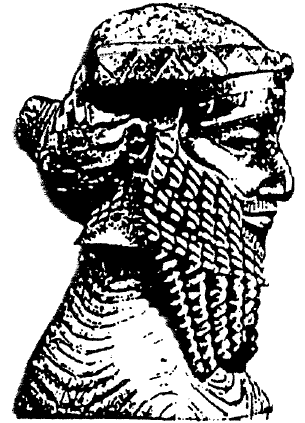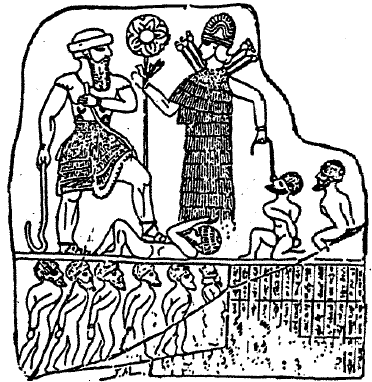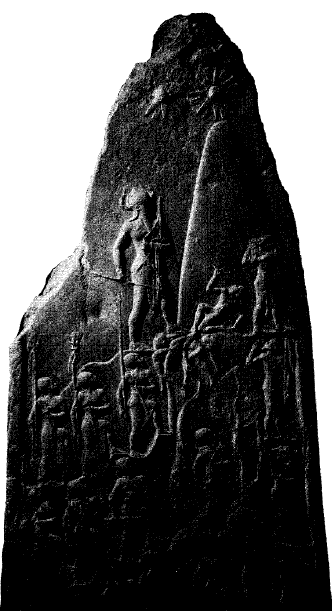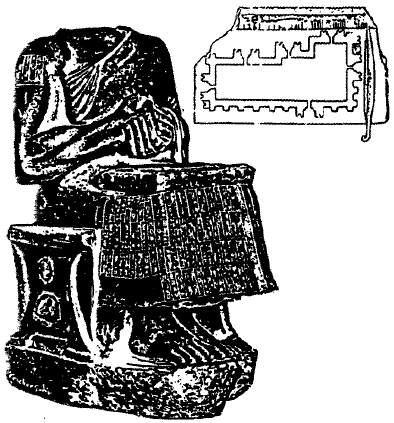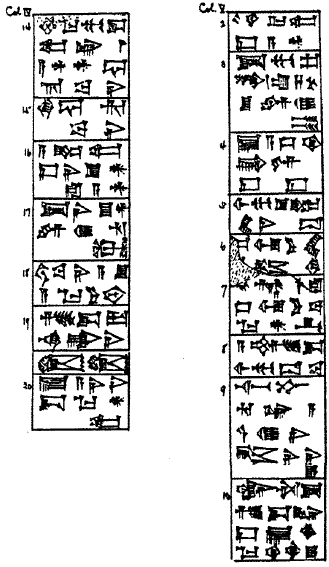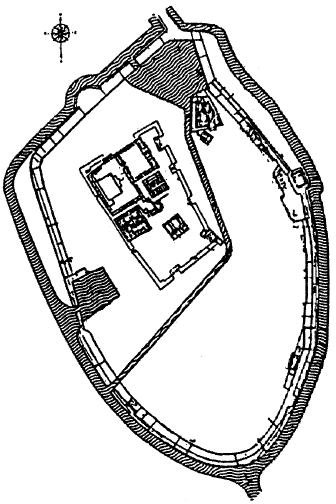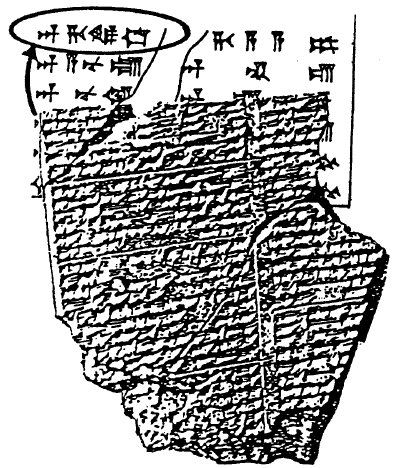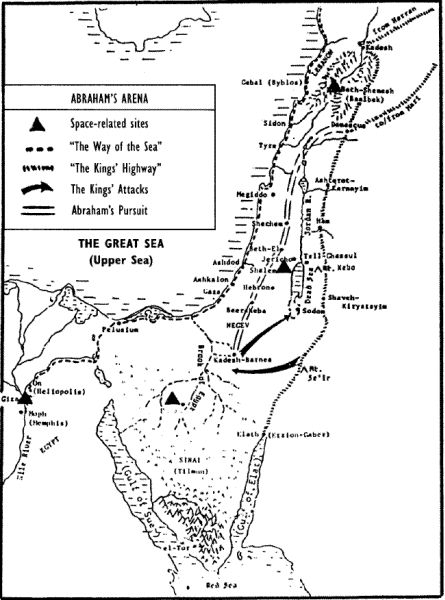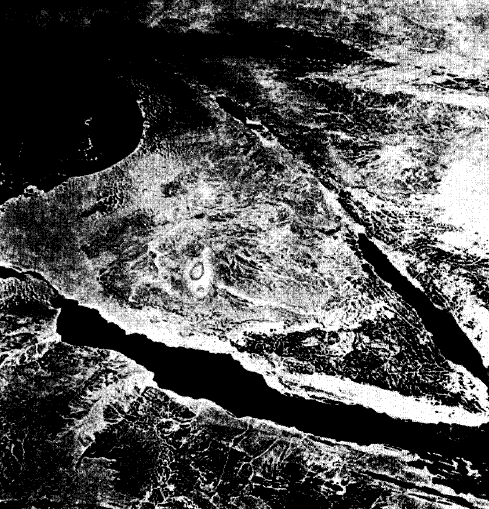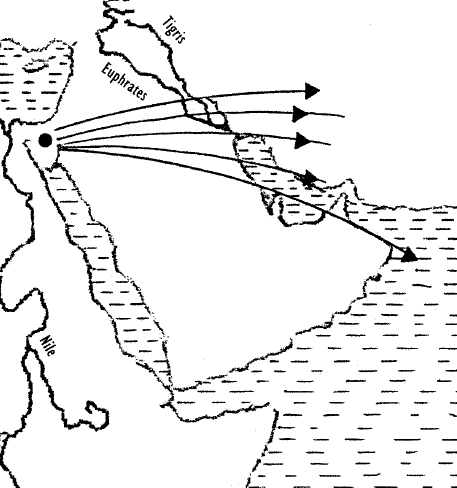|
So did a gardener later known as Sharru-kin (‘Sargon’ in English) describe his chance encounter with the goddess Inanna.
Since the goddess, weary from her flying about, was asleep, one cannot say that it was a case of ‘Love at first sight’; but from what ensued it is obvious that Inanna liked the man and his lovemaking.
Inanna’s invitation to him to her bed, with the throne of Sumer thrown in, lasted 54 years:
How did Inanna persuade the Anunnaki leadership to entrust Sumer and its people - here called by their nickname Sag.ge.ga, the Black-Headed Ones - to the man whose kiss changed history, is nowhere made clear.
His name-title Sharru-kin (= ‘Truthful Ruler’) was not Sumerian; it was in the ‘Semitic’ tongue of the Amurro, the ‘Westerners’, of the ‘Semitic’ speaking region northwest of Sumer; and his features, preserved in a bronze sculpture (Fig. 101), confirm his non- Sumerian extraction.
Figure 101
The brand-new capital city built for him, Agade, was better known by its ‘Semitic’ name Akkad - from which the term Akkadian for the language.
Indeed, some of the earliest Sumerian depictions that scholars call ‘Libation scenes’ might be depictions of the king (bare naked to show total subservience) acting as cupbearer for the deity (see Fig. 77).
Urzababa was a king in Kish, and the statement implies that Sargon was a royal prince there. Yet Sargon himself, in the autobiographical text known as The Legend of Sargon, chose to wrap his origin in mystery:
Then, as in the story of the birth of Moses in Egypt a thousand years later, Sargon continued:
The explanation for Sargon’s odd avoidance of claiming princehood might be found in the fact that in time Sargon’s own daughter Enheduanna served as high-priestess-cum-hierodule in the temple of the god Nannar/Sin in Ur - a position deemed one of great honor.
By claiming the same position for his mother, Sargon left open the possibility that his ‘unknown father’ might have been a god - which would make him, Sargon, a demigod.
The same thinking, of making adversaries part of the family, probably led to the decision to establish a new, neutral national capital whose name meant ‘Union’; its location marked the addition of territories called Akkad, north of olden Sumer, to create a new geopolitical entity called ‘Sumer & Akkad’; and henceforth, Inanna was widely known by her Akkadian name Isktar.
Bringing one olden city after another under his control, he turned his prowess against neighboring lands.
To quote from a text known as The Sargon Chronicle,
For the first time since its inception millennia earlier, the whole First Region was firmly ruled from a national capital, from the Upper Sea (the Mediterranean) to the Lower Sea (the ‘Sea in the East’, the Persian Gulf); in that, it was the first historically known empire - and quite an empire it was:
And though Sargon acknowledged (when necessary) the authority of Enlil, Ninurta, Adad, Nannar, and Utu, his conquests were carefully carried out "by the order of my mistress, the divine Ishtar." It was indeed, as the inscriptions said, the Era of Ishtar.
A grand new temple for Sitar made clear which deity held sway over all of that:
It was the crown jewel of shrines to her that had to be erected in virtually every Sumerian city, outshining even the sacred Eanna in Uruk; and that was a mistake.
Now Sargon,
To understand the severity of this unauthorized act, one needs recall that Bab-ili (as ‘Babylon’ was called in Akkadian) meant ‘Gateway of the Gods’, a sanctified place; and that Marduk was persuaded to give up his attempt on condition that the site will be left undisturbed, as ‘hallowed ground’.
Now Sargon "took away soil from the foundations of Babylon" to use as foundation soil for another Gateway of the Gods, adjoining Agade.
The sacrilege naturally enraged Marduk, and reignited the clan conflicts. But Sargon not only broke the taboo regarding Babylon - he also planned to create at Agade his (or Inanna’s?) own ‘Gateway of the Gods’; and that angered Enlil.
With the consent of Enlil, she placed Sargon’s son Rimush on the throne in Agade; but he was replaced after a brief nine years by his brother Manishtushu, who lasted fifteen years. Then Naram-Sin, the son of Manishtushu, ascended the throne - and once more, Inanna/Ishtar had as king a man to her heart’s desire.
Capably building on the imperial foundations attained by his grandfather, he combined military expeditions with the expansion of commerce, sponsoring trading posts by Sumerian merchants in far-flung places and creating trade routes on an international scale, reaching as far north as the boundary of the Hittite domain of Ishkur/Adad, Nannar’s brother.
Highlighting the fact that his spouse, Sarpanit, was an Earthling and that his Earthborn son Nabu also married one (named Tashmetum), Marduk was gaining adherents among the masses. In Egypt, where Marduk/Ra has been worshipped as the hidden Amen/Amon, the expectations for Marduk’s ultimate victory were reaching messianic fervor, and Egyptian Pharaohs began to thrust northward, to seize control of the Mediterranean’s coastal lands.
Capturing what was later known as Canaan, he kept advancing all the way south to Magan (ancient Egypt). There, his inscriptions state, "he personally caught the king of Magan."
His merciless advance and capture of adversary kings was commemorated on a stone plaque that showed a glowing Ishtar offering him a victory wreath (Fig. 102). Having entered and crossed the forbidden Fourth Region with its Spaceport, Naram-Sin haughtily depicted himself on a victory stela (Fig. 103) godlike astride a rocketship to the heavens.
He then went to Nippur to demand that Enlil endorse him as "King of the Four Regions."
Figure 102
Figure 103
Enlil was not there; so,
These were unprecedented acts of disobedience and sacrilege; Enlil’s reaction is detailed in a text known as The Cursing of Agade.
He summoned the Anunnaki leadership to an Assembly; all the great gods, Enki included, attended - but Inanna did not show up. Ensconed in the venerated Eanna temple in Uruk, she sent back defying words, demanding that the gods declare her "Great Queen of Queens" - the supreme female deity.
In their Assembly, the gods’ decision was made - to put an end to all that by wiping Agade off the face of the Earth.
Troops loyal to Ninurta from Gutium, a land across the Zagros Mountains, were
brought in, and they systematically destroyed Agade to oblivion. The
gods decreed that its remains shall never be found; and indeed, to
this day, no one is even certain where exactly Agade had been
located. With the death of the city, Naram-Sin too was gone from the
records. As to Inanna/Ishtar, her father Nannar/Sin fetched her from Uruk to Ur.
By 2255 B.C., the ‘Era of Ishtar’ was over.
But the empire which she had brought about - as well as the challenges to olden authority - left their permanent mark on the ancient Near East.
De facto the country was administered by Ninurta from his ‘cult center’ in Lagash - a city whose written records, artifacts, and sculptures have served as a major source of information about Sumer, the Sumerians, and the Sumerian civilization.
Dynastic rule continued in Lagash uninterrupted for more than half a millennium, indicating outstanding stability throughout turbulent times; the list of its kings runs to 43 names!
A king named Urukagina instituted, some 4,500 years ago, a code of laws that prohibited the abuse of official powers, the "taking away" of a widow’s donkey, or the delay by a supervisor of the wages of daily workers. Public works, such as canals for irrigation and transportation, and communal buildings, were deemed a personal duty of the king.
Festivals that involved the whole populace, such as the Festival of First Fruits, were introduced; literacy, evidenced by some of the most perfect cuneiform script, was encouraged; and some of the finest Sumerian sculptures - two thousand years before classic Greece! - come from Lagash (see Figs. 31, 33).
So it was from Lagash that Ninurta restored Enlilite authority and brought about a century of respite to Sumer after the Inanna/Naram-Sin upheavals; but it was a shrinking Sumer & Akkad, subjected to relentless pressures as Marduk continued to seek Supremacy on Earth.
The story, which is recorded on clay cylinders that are now on display in the Louvre museum in Paris, began with a dream that Gudea had. In the dream, "a man, bright and shining like heaven ... who wore the headdress of a god" appeared and commanded Gudea to build him a temple. A female, "a woman carrying the structure of a temple on her head," appeared next; holding a tablet with a celestial map, she pointed at a particular star.
Then a second male deity appeared, holding in one hand a tablet with a design on it and in the other hand a building brick.
The goddess is Nisaba:
The other god is Ningishzidda; the sacred brick he gave you, is to be used as a mold; the carrying-basket means that you have been assigned the task of construction; the tablet with the design on it is the architectural plan of the seven-stage temple; its name, she said, shall be E.Ninnu.
The architectural requirements, he found out, were far from simple; there was to be at the top a domed observatory - "shaped like the vault of heaven" - to determine star and planetary positions after nightfall, and in the forecourt two stone circles were to be erected to determine constellations the moment of sunrise on Equinox Day.
There was also need to construct two special sunken enclosures, one for Ninurta’s aircraft, the "Divine Black Bird," and the other for his "Awesome Weapon."
In his clearly written inscriptions in perfect Sumerian script (example, Fig. 105) Gudea states that he had to go back repeatedly to the deities for guidance, and "had no good sleep until it was completed."
At one point he was ready to give up, but in a "command-vision" was ordered,
The preliminary events and details of the complex construction are inscribed on what is called Gudea Cylinder A.
‘Cylinder B’ is devoted to the elaborate rites connected with the temple s inauguration - precisely on New Year’s Day - and the ceremonies attendant on the arrival of Ningirsu and Bau at the Girsu and their entry into their new temple-home.
These texts also shed light on the manner of his birth: The goddess Nina brought him forth from seed implanted in her womb by the goddess Bau:
Gudea, in other words, asserted that he was a demigod, engendered by Bau and Nina of the Enlil/Ninurta clan.
The active participation of Ningishzidda/Thoth in the project was especially significant, since he was a son of Enki/ Ptah and a half-brother of Marduk/Ra, with whom he had repeatedly quarreled. That was not the only inner rift with Marduk: His other half-brother, Nergal (spouse of Enlil’s granddaughter Ereshkigal), also sided frequently with the Enlilites.
The growing problem for the Enlilites was the fact that Ninurta, the presumptive heir to Enlil and Anu, had come from Nibiru - whereas Marduk and Nabu had Earthling affinities. In desperation, the Enlilites dropped the ‘Ninurta Strategy’ and switched to a ‘Sin Tactic’, transferring the seat of national Kingship to Ur - the ‘cult center’ of Nannar, an Earthborn son of Enlil, who unlike Ninurta also had an Akkadian name: Sin.
His selection was meant to signal to people everywhere, even in the "rebel lands," that under his leadership an era of peace and prosperity will begin.
One of the buildings within the walled section was the Gipar (= ‘Nighttime Abode’) within which was the Gigunu, the ‘Chamber of nighttime pleasures’ for the god; for though Nannar/Sin was monogamous and had only one spouse (Ningal), he could (and did) enjoy in the Gipar the company of hierodules (‘Pleasure Priestesses’) as well as concubines (by whom he could have children).
Figure 106
The imposing ziggurat with its monumental stairways (see Fig. 35), though long in ruins, dominates the landscape to this day, even after more than 4,000 years.
Born in Uruk, he was a son - "the beloved son" - of the goddess Ninsun (who had been the mother of Gilgamesh) - a birth (according to the inscriptions) approved by Anu and Enlil and witnessed by Nannar/Sin.
Since this divine genealogy (including the claim that Ninharsag helped raise him) was restated in numerous inscriptions during Ur-Nammu’s reign, in the presence of Nannar and other gods, one must assume that the claim was factual, it was a claim that placed Ur-Nammu in the very same status as that of Gilgamesh, whose exploits were well remembered and whose name remained revered.
The choice was thus a signal, to friends and foes alike, that the glorious days under the unchallenged authority of Enlil and his clan were back.
Enlil and Ninlil were honored with renovated and magnified temples; and for the first time in Sumer’s history, the priesthood of Nippur was combined with that of Ur, leading to a religious revival. (It was at that time, by our calculations, that the Omen Priest Terafa, Abram’s father, was transferred from Nippur to Ur.)
But as great a builder and economic ‘shepherd’ as he was, he failed as a military leader: In the midst of battle his chariot got stuck in the mud; Ur-Nammu fell off it and was "crushed like a jug."
The tragedy was compounded when the boat returning Ur-Nammu’s body to Sumer,
When news of the defeat and the tragic death of Ur-Nammu reached Ur, a great lament went up.
The people could not understand how such a religiously devout king, a righteous shepherd - a demigod! - could perish so ingeniously.
There could be only one plausible explanation, the people of Ur and Sumer concluded: "Enlil deceitfully changed his decree" - these great gods went back- on their word; and faith in them was profoundly shaken.
Situated at the headwaters of the Euphrates River and located at the crossroads of international trade and military land and river routes, Harran was surrounded by fertile meadows perfect for sheepherding. It was founded and settled by merchants from Ur who came there for its local sheep’s wool, skins, and leather and imported metals and rare stones, and brought in exchange Ur’s famed woolen garments and carpets.
The city also boasted the second largest temple to Nannar/Sin after Ur and was often called "the second Ur."
Eager to claim the status of a demigod as that of his father, he asserted in his inscriptions that he was born under divine auspices: The god Nannar himself arranged for the child to be conceived in Enlil’s temple in Nippur through a union between Ur-Nammu and Enlil’s high priestess, so that,
He got into the habit of calling the goddess Ningal, Nannar’s spouse, "my mother" and Utu/Shamash (their son) "my brother."
He then asserted in self-laudatory hymns that "a son born of Ninsun am I" (though in another hymn he was her son only by adoption). These different and contradicting versions cast doubt on the validity of his claims to demigodship.
On the way, he paused to worship at the "Place of Bright Oracles" - the place we know as Jerusalem. Having thus venerated the three space-related sites, he followed the ‘Fertile Crescent’ - the arching trade and migration east-west route dictated by geography and water sources - and returned to Sumer.
In numerous love songs that have been found in the ruins of Ur, he boasted that Inanna "granted me her vulva in her temple."
It was called the ‘Great West Wall’, and scholars believe that it ran from the Euphrates to the Tigris Rivers north of where Baghdad is situated nowadays. An unintended result of that was that the heartland of Sumer was cut off from the provinces in the north.
In 2048 B.C. the gods, led by Enlil, had enough of Shulgi’s state failures and personal dolce vita, and decreed for him "the death of a sinner."
Significantly, it was exactly then that, by divine order, Abram left Harran for Canaan... Also in that same year, 2048 B.C., Marduk arrived in Harran, making it his headquarters for the next 24 years. His arrival there, recorded in a well-preserved clay tablet (Fig. 107), posed a new and direct challenge to Enlilite hegemony.
Besides the military significance, the move deprived Sumer of its economically vital commercial ties.
A shrunken Sumer was now under siege.
Figure 107
Individual site names reveal that those places included the all-important Landing Place in Lebanon and the Mission Control city of Shalem (alias Jerusalem).
And then came Marduk’s claim that the Spaceport Region was no longer neutral - it was to be considered a Marduk and Nabu domain. With Egypt his original dominion, he now controlled all the space-related facilities.
And so it was that in the 7th year of his reign, in 2041 BC., Amar-Sin led a great military alliance against the "sinning cities" in the west (including Sodom and Gomorrah), hoping to regain control of the Spaceport; he was, I have suggested in The Wars of Gods and Men, the ‘AmarpheF of Genesis 14.
He then pursued the retreating invaders all the way to Damascus (nowadays Syria), to rescue his nephew Lot whom they had taken captive in Sodom.
Figure 108
The conflict
between the gods was clearly becoming a far-flung multi-nations war.
He was replaced by his brother Shu-Sin; the data for his nine years’ reign record two military forays northward but none westward; they speak mostly of his defensive measures. He relied mainly on building new sections of the Wall of the West; the defenses, however, were moved each time ever closer to Sumer’s heartland, and the territory controlled from Ur kept shrinking.
Directing and prompting the Westerners was Nabu. His divine father, Marduk himself, was waiting in Harran for the recapture of Babylon.
Ironically, it was his own two brothers who pointed out that astronomically observed, the zodiacal constellation of the Ram had not yet begun: Ningishzidda said so from the observatory in Lagash, and Nergal from the scientific station in the Lower World. But his brothers’ findings only angered Marduk and intensified Nabu’s recruiting of fighters for Marduk.
As in a movie - usually a crime thriller - in which the various eye witnesses and principals describe the same event not exactly the same way, but from which the real story emerges, so are we able to retrieve the actual facts in this case.
The year, 2024 B.C., marked the 72nd anniversary of his life on the run - the time it takes the zodiacal circle to move one degree.
It was 24 years since he had been waiting in Harran; and he asked:
Called to make the Enlilite case, Ninurta blamed everything on Marduk, even accusing his followers of defiling Enlil’s temple in Nippur.
Nannar/Sin’s accusations were mainly against Nabu. Nabu was summoned, and "Before the gods the son of his father came." Speaking for his father, he blamed Ninurta; voicing accusations against Nergal, he got into a shouting match with Nergal (who was present); and "showing disrespect, to Enlil evil he spoke," accusing the Lord of the Command of injustice and of condoning destruction.
Enki spoke up:
His ire was directed especially at his son Nergal:
The two argued so much that in the end Enki shouted to Nergal to get out of his presence.
Based on our current level of technology, they can be described as seven nuclear devices:
They were brought to Earth unintentionally from Nibiru by the fleeing Alalu, and were hidden away in a secret safe place a long time ago; Enki knew where; so did Enlil.
He made clear that his approval for the unprecedented step of using the "Awesome Weapons" was limited to depriving Marduk of the Sinai Spaceport, but that neither gods nor people should be harmed:
Choosing Nergal and Ninurta to carry out the mission, the gods made absolutely clear to them its limited and conditional scope.
The other two went ahead to Sodom, where Abraham’s nephew Lot dwelt. That night, we know from the Erra Epos, Ishum/Ninurta "to the Mount Most Supreme set his course" in his Divine Black Bird.
Arriving there,
With two pinpointed nuclear drops, the Spaceport was obliterated by Ninurta - first the ‘Mount Most Supreme’ (‘Mount Mashu’ of the Gilgamesh Epic) with its inner tunnels and hidden facilities; then the adjoining plain that served for landing and takeoff.
The scar in the Sinai Peninsula is still visible to this day, as a NASA photograph from space shows (Fig. 109); the plain - amid white limestone mountains - is still covered with crushed and thoroughly burned and blackened rocks.
Figure 109
According to the Sumerian texts, Ninurta tried to dissuade Nergal from carrying it out. According to the Bible, it was Abraham who pleaded with one of the three Angels who had dropped-in on him to spare the cities if as few as ten "righteous ones" shall be found in Sodom.
That evening, in Sodom, two Angels sent to verify whether the cities should be spared were mobbed by a crowd seeking to sodomize them. "Upheavaling" was inevitable; but they agreed to delay it in order to give Lot (Abraham’s nephew) and his family enough time to escape to the mountains.
Then at dawn,
Sodom and Gomorrah and three other cities in "the disobedient land, he obliterated."
The Bible, in virtually identical words, relates that "as the sun was risen over the Earth, from the skies were those cities upheavaled, with brimstones and fire that have come from Yahweh."
Five nuclear devices, dropped by ‘The Annihilator’ Nergal, did it.
It was a terrible, gruesome death: Wherever the Evil Wind reached,
It was not a natural calamity:
It was the result of an explosion:
It was triggered by nuclear devices - "caused by seven awesome weapons in a lightning flash"; and it came from the Plain of the Dead Sea:
Forewarned of the Evil Wind’s direction, the gods fled Sumer in panic.
Long Lamentation Texts, such as Lamentation Over The Destruction of Sumer and Ur, list the cities and the temples that were "abandoned to the Wind" and describe the haste, panic, and grief as each deity fled, unable to help the people. ("From my temple like a bird I was made to flee," Inanna lamented.) Behind them temples, houses, animal stalls, all buildings remained standing; but everything alive - people, animals, vegetation - died.
Texts written even centuries later recalled that day, when a cloud of radioactive dust reached Sumer,
|
